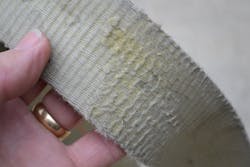Topic: Working load limit old vs new destructive testing
Objective: Destructive testing to compare the Working Load Limit (WLL) of older 2-inch-wide tie-down ratchet units compared to brand-new units.
Task: The rescue team shall review their vehicle rescue ratchet strap units and determine the condition of existing 2-inch-wide tie-down ratchet strap units currently in-service within the rescue tool inventory.
The popularity of 2-inch-wide ratchet tie-down units has increased within the fire and rescue services due to its widespread use as part of rescue strut stabilization systems. This piece of rescue equipment is, however, vulnerable to damage and equipment “injury” and must be properly maintained. Our testing reveals that relatively minor damage to your ratchet tie-down unit can significantly increase the possibility of failure during use. What follows is the story of how an in-service ratchet tie-down unit can appear fine and yet demonstrate a significantly reduced load-carrying capacity.
Rescuers using 2-inch-wide tie-down ratchet strap units with twin hook ends should know that the working load limit (WLL) rating of these units is 3,330 pounds with a 3:1 safety ratio. Two important teaching points must be understood about this WLL number. First, this rating is generated for a brand-new, off-the-shelf, tie-down ratchet strap assembly. Secondly, when a new ratchet unit has a WLL of 3,330 pounds (3:1), that means that ultimate failure would be expected when the load exceeds 3 times that or approximately 10,000 pounds.
Destructive testing
To determine the difference between the WLL of a brand-new tie down and a 3-year old, in-service unit, research testing was conducted in cooperation with officials at B/A Products, Columbia, MD.
The used, in-service ratchet tie down was in good condition—stitching at each end of the webbing was intact, the twin hooks at each end were undamaged, and the metal ratchet assembly itself was fully functional.
The used Vulcan-brand tie-down unit that was tested, however, had three areas on the webbing that were noted as “minor” damage. There were several grease impregnated stains on the webbing. Another area showed old diesel fuel or gasoline stains and yet another area on the webbing showed some abrasions.The destructive testing conducted on the tie-down assembly used a special machine at the B/A facility that had a fixed end and a moveable end. With the ratchet connected, the testing machine pulls or stretches the unit until something fails. A computer and load sensor connected to the testing machine continually measures the load applied and provides both a digital readout and a graph chart.
During the series of destructive testing, the older tie-down unit failed and broke apart at approximately 5,600 pounds of pulling force. The point of failure was in the webbing, exactly at the point where the synthetic fibers had been abraded and were showing signs of minor wear.
The 3-year old unit failed at only 56 percent of its ultimate failure load rating of 10,000 pounds. This reduced load-carrying capacity is important to note for several reasons. Because the failure point of 5,600 pounds was actually above the ratchet’s WLL of 3,330 pounds, if the WLL of the ratchet tie down were not exceeded, webbing failure would not have occurred.
Secondly, the failure point was at the abrasions on the webbing. Wear and tear on the fibers of the webbing was a more fatal problem than the fuel stains or the grease smears.For comparison purposes, a brand-new, off-the-shelf 2-inch-wide ratchet tie down unit was tested. When pulled to failure, the new unit failed at 10,188 pounds of load—over 3 times its WLL. This reinforces the logic behind keeping all our rescue equipment, including ratchet tie-down assemblies, in good condition and maintained below the tool’s listed WLL when at technical rescue incidents.
When inspecting the tie-down units used by a fire/rescue organization, personnel should pay close attention to the overall physical condition of the entire assembly. Even seemingly minor damage to a tie down, such as webbing abrasions in this case, can significantly reduce its capacity to hold objects and increases the chance that the tie down will fail. Therefore, it is very important that tie downs are regularly and properly inspected. In reality, there simply is no such thing as “minor” damage.Association recommendations
The Web Sling and Tie Down Association (wstda.com), based in Forest Hill, MD, offers a free downloadable safety bulletin that outlines proper inspection and maintenance of web tie-down units that fire and rescue groups utilize.
Among their listing of recommendations for tie-down webbing use is the statement that the entire tie down be inspected before each use. Webbing and tie-down unit inspection should also be integrated into our routine rescue tool and equipment checks that we do at the station. They also recommend that the tie down be removed from service if damage of any kind is detected during this inspection.
The Association advises that if you are not sure whether your tie down is damaged or whether what you see is significant enough to affect the performance of the tie down, the unit should not be used. The destructive testing of the older tie-down unit that had some relatively minor-looking webbing abrasions proves just how important this advice is.

Ron Moore
RON MOORE, who is a Firehouse contributing editor, recently retired as a division chief with the McKinney, TX, Fire Department and now serves with Prosper, TX, Fire Rescue. He self-published the Vehicle Rescue 1-2-3 training manual and serves as the forum moderator for the extrication section of Firehouse.com . Moore can be contacted directly at [email protected].










